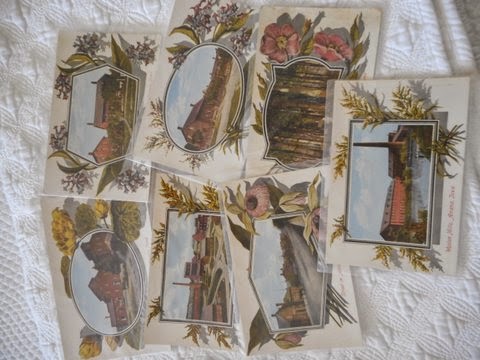Tuesday, September 16, 2014
Amana Postcards
As tourism increased in the Amana Colonies after 1932, there were several ways to advertise and correspond in and out of Amana. Postcards were printed and common across the USA from about 1900-1960's and used to send cheap greetings for any reason- the text message and social media of that era that started in England in the late 1800's. In the early 1900's salesmen who were photographers themselves, traveled the nation's Byways and sold cards in bulk to stores of their town images. The cards helped propel tourism. They came in many styles (linen paper, real photo, silk, artistic signed, chrome), some colored , some in black and white, others sepia brown. There were plain borders, floral borders and more. Some were printed in Germany while others were printed here in the United States. Special, real photos were made into postcards by mail as well. They showed scenes of all famous Amana landmarks, landscapes, people, architecture, disasters, and animals. Simple scenes were postcard worthy in Amana. They showed how Amana was changing and developing. Below is the Amana print works and men hauling ice with the ice wagon and cutter. Hard to find, I find these to be beautiful pieces of art, records of history, and very collectible. Podunk photo.
Friday, September 5, 2014
The Fire Bucket
| 1848 Enenezer NY bucket |
Each village of the Amana Colonies had its water works and fire engine. Every strong man was a member of the fire department. The water supply came from deep artesian wells, the one in Amana being 600 feet deep. The one in Homestead was 2100 feet deep, supplying water for all the village needs. Men would form long lines, fill the fire buckets with that water and pass them down the lines to put a fire out. Buckets were made of tough leather, tightly stitched by the harness makers or shoe makers and printed with black letters to identify its station. The bucket handle was rolled and sewn, very strong. There was a bucket by each stove so it was readily available in case of fire. Early buckets in American history were made of gourds or leather. This is a very necessary, well made object now seen as a rare art form. They have quite a heritage, age, and design...The Amana Heritage Museum owns the black one.
Subscribe to:
Posts (Atom)














